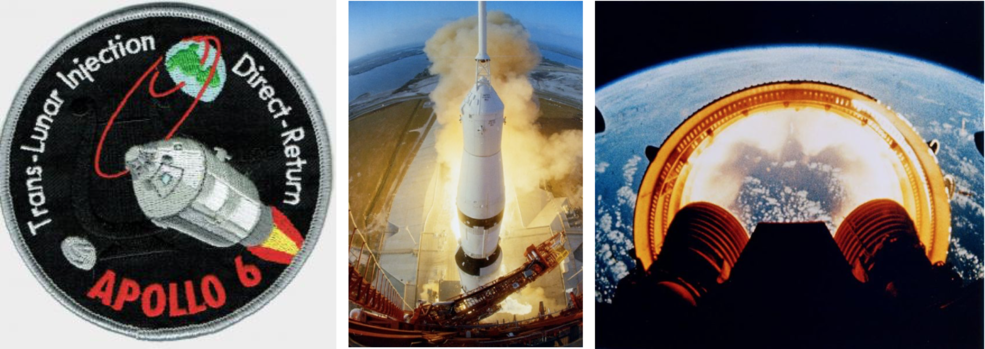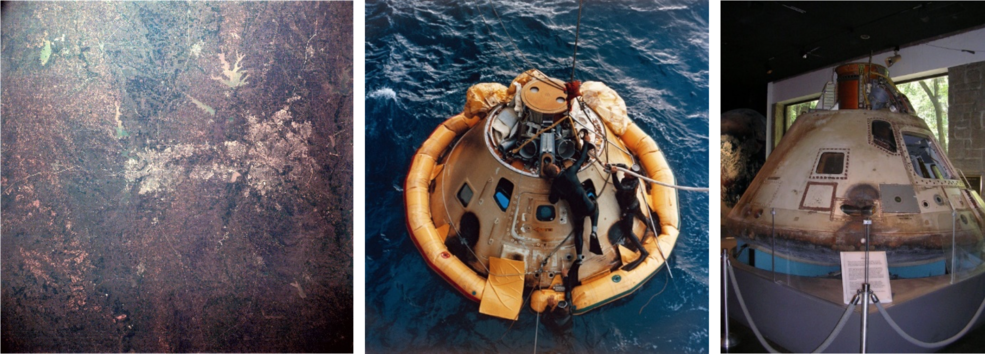50 years ago, on the way to the Moon…
Following on the heels of the two very successful Apollo 4 and 5 missions, Apollo 6 was the second all-up unmanned test of the Saturn 5. The plan called for the first three stages to place the spacecraft still attached to the third stage into low Earth orbit. Then, to simulate a Translunar Injection (TLI), the third stage would reignite to send the spacecraft into a highly elliptical Earth orbit. Soon after TLI, the Service Module (SM) engine would fire to slow the spacecraft down in a simulation of a direct-return abort, with Apollo 6 reaching an altitude of about 14,000 miles before descending back toward Earth. The SM engine would fire again to increase the spacecraft’s speed on reentry to about 25,000 miles per hour to mimic a lunar return, much as happened on Apollo 4.
The second Saturn 5 lifted off from the Kennedy Space Center’s Launch Complex 39A on April 4, 1968; the mission ran into trouble from the start. Two minutes into the flight, the first stage experienced about 30 seconds of vertical oscillations known as “pogo effect”, which caused no serious damage but would have been very uncomfortable for any crew. Then during the second stage burn, two of the five engines shut down prematurely. The remaining three engines burned longer to compensate for the reduced thrust, as did the third stage to propel Apollo 6 into orbit. When it was time for the third stage to restart, it simply wouldn’t. The flight control team led by Flight Director Clifford Charlesworth decided on an alternate mission plan to separate the spacecraft from the third stage and use the SM engine instead to reach the nearly 14,000-mile altitude. But this used so much fuel that the second SM burn could not be carried out, so reentry occurred at less than the planned speed. Apollo 6 splashed down in the Pacific Ocean after a troubled flight of 9 hours and 57 minutes and was recovered aboard the aircraft carrier USS Okinawa. The spacecraft is on display at the Fernbank Science Center in Atlanta, Georgia.
The rocket problems notwithstanding, Apollo 6 returned some stunning photographic results. Camera pods in the second stage that were jettisoned and recovered after launch recorded some stunning film of the first stage separation, imagery that has become iconic of Saturn 5 launches (and often incorrectly attributed to Apollo 11). While Apollo 6 was orbiting the Earth, the spacecraft’s special 70-millimeter camera obtained some spectacular color stereo photographs. These were later found to be excellent for cartographic, topographic, and geographic studies of continental areas, coastal regions, and shallow waters. The camera photographed sections of the United States, the Atlantic Ocean, Africa, and the western Pacific Ocean, and had a haze-penetrating film and filter combination that provided better color balance and higher resolution than any photographs obtained during the Mercury and Gemini flights.
Apollo 6 did not garner much press attention as major events in the country overshadowed the mission. Only four days before the flight, President Lyndon B. Johnson made the surprising announcement that he would not seek reelection. About an hour after the Apollo 6 splashdown, an assassin’s bullet took the life of civil rights leader Rev. Martin Luther King in Memphis, Tennessee. Within NASA, the focus was still on accomplishing President John F. Kennedy’s goal of landing a man on the Moon before the end of the decade. After detailed analysis of the Saturn 5’s less than perfect performance by engineers at Marshall Space Flight Center, NASA managers decided they could solve the pogo issue and the engine malfunctions and that another unmanned test flight was not necessary – the next Saturn 5 would carry a crew! And as events unfolded, it was to be more than just the first manned flight of the Moon rocket.
Read about flight controller Jay Greene’s experience during Apollo 6 in his November 10, 2004, oral history with the JSC History Office:
https://historycollection.jsc.nasa.gov/JSCHistoryPortal/history/oral_histories/GreeneJH/greenejh.htm
























